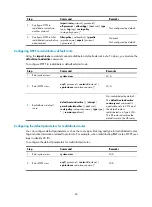
70
Figure 36
NSSA external LSA format
Supported features
Multi-process
This feature allows multiple OSPF processes to run on a router both simultaneously and independently.
Routing information interactions between different processes simulate interactions between different
routing protocols. Multiple OSPF processes can use the same RID.
An interface of a router can only belong to a single OSPF process.
Authentication
OSPF can authenticate OSPF packets. Only packets that pass the authentication are received. If an
incoming hello packet cannot pass authentication, the neighbor relationship cannot be established.
The authentication type for interfaces attached to a single area must be identical. Authentication types
include non-authentication, plaintext authentication, and MD5 ciphertext authentication. The
authentication password for interfaces that are attached to a network segment must be identical.
OSPF Graceful Restart
Graceful Restart (GR) ensures the continuity of packet forwarding when a routing protocol restarts or an
active/standby switchover occurs:
•
GR Restarter
—Graceful restarting router. It must have GR capability.
•
GR Helper
—A neighbor of the GR Restarter. It helps the GR Restarter to complete the GR process.
After an OSPF GR Restarter restarts, it must perform the following tasks.
•
Obtain OSPF neighbor information.
•
Obtain the LSDB.
Before restart, the GR Restarter negotiates GR capability with GR Helpers. During the restart of the GR
Restarter, GR Helpers still advertise their adjacencies with the GR Restarter. After restart, the GR Restarter
sends GR Helpers an OSPF GR signal so that the GR Helpers do not reset their neighbor relationships
with the GR Restarter. Upon receiving responses from neighbors, the GR Restarter creates the neighbor
relationships.
After that, the GR Restarter synchronizes the LSDB with GR-capable neighbors, updates its routing table
and forwarding table, and removes stale routes.
















































